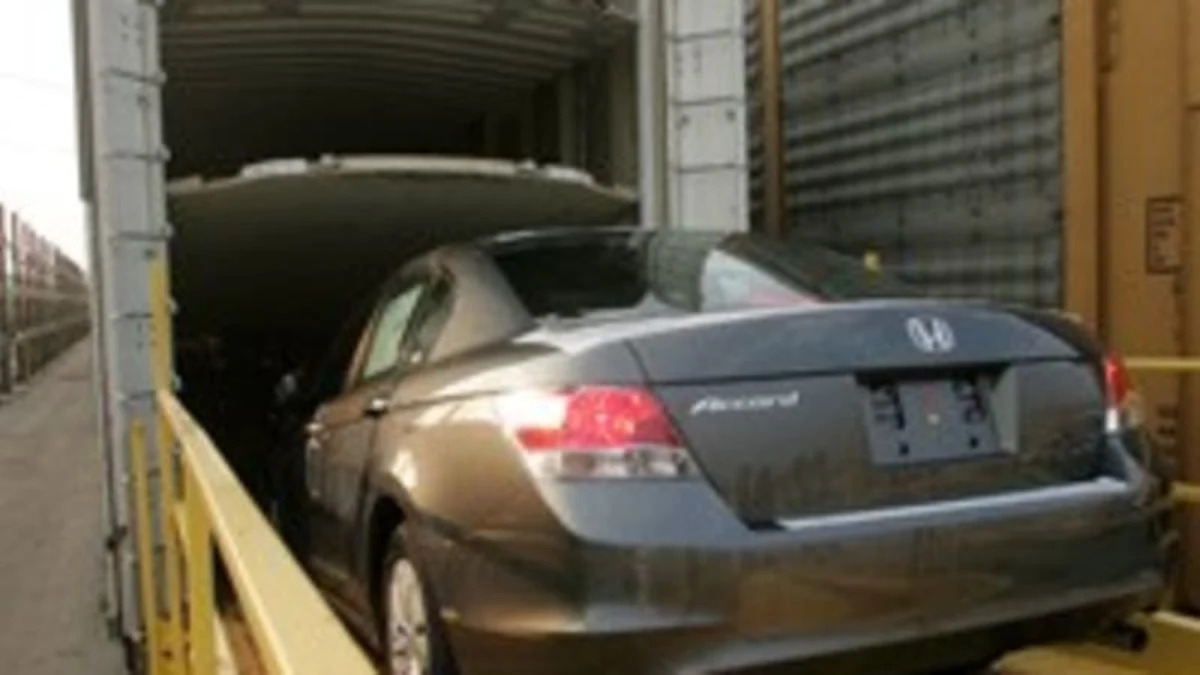The video meant to be presented here is no longer available. Sorry for the inconvenience.
This is just the kind of car company that Honda is. Sure, it sinks tons of R&D into its automobiles so they go faster, handle better, feel nicer and get better fuel economy, but while they're at it, the good folks at Honda also do things like build jets and revolutionize rail transport. That's right, along with cars and planes, Honda has worked its magic on trains and developed the Auto-Max railcar. You see, Honda transports 82% of all its soon-to-be-sold autos via rail in the United States. Why? Because it's more "environmentally responsible" than using trucks. Well, Honda had an issue with current bi-level rail cars outfitted to transport vehicles because they can only hold 10 cars and operate for 20 years. So Honda did what it does and developed the Auto-Max, which will hold 22 cars and run for 50 years. And now its got a fleet of 400 operating in the U.S. The Japanese automaker also upgraded the rail infrastructure around its Marysville and East Liberty, Ohio assembly plants so trains can pull in and out faster and shipments get on their quicker. Being from Ohio, I can tell you that this state really is the heart of it all when it comes to rail, so it's not surprising that Honda has taken advantage of this shipping method to save some cost and look a little more green. We can't wait to see what the Auto-Max Si can do.
[Source: Honda]
PRESS RELEASE
Honda Launches Auto-Max Railcar Fleet: More environmentally-responsible product distribution with industry-first fleet
Honda (http://www.honda.com) has fully deployed its fleet of Auto-Max® railcars, achieving a significant reduction in the fuel consumption and CO2 emissions associated with its automobile distribution activities in the United States. The 400-car fleet of more space-efficient Auto-Max railcars is the only such automaker-operated fleet in use in the United States. Including the Auto-Max fleet shipments, American Honda currently transports about 82 percent of its Honda and Acura automobiles across the country by rail, achieving the highest rail-shipping rate of any automaker.
Each multi-level Auto-Max railcar holds up to 22 vehicles and can hold both trucks and cars to reduce unused space. The result is less fuel usage per vehicle shipped and no compromise to quality. An average bi-level railcar can transport only 10 trucks, generally of a single vehicle type.
Honda's Auto-Max railcars have a 50-year estimated lifespan versus standard railcars, which typically require a major overhaul after just 20 years of service. Honda participated with the Greenbrier Companies (NYSE:GBX) in designing Auto-Max, which is exclusively manufactured by Greenbrier.
"Honda is adopting a holistic approach to minimizing its greenhouse gas emissions, addressing not only the production and on road use of our products, but also new, more fuel-efficient strategies for how we transport our products to dealers," said Dennis Manns, assistant vice president, Sales & Logistics Planning for American Honda Motor Co., Inc. "Rail is the most environmentally responsible method available to move our products, and our Auto-Max railcar fleet can make a good system even more fuel efficient."
To further support Honda's strategy to increase product distribution by rail, Honda this year invested approximately $7 million to redesign the rail infrastructure at its automobile plants in Marysville and East Liberty, Ohio. The redesign added rail capacity, enabling American Honda to ship more units via rail. Further, inbound and outbound trains at the plant can now operate at a faster pace; pull easier on upgraded tracks; and, require less railcar switching in the yard, reducing fuel consumption, CO2, and other air pollutants emissions that are produced while engines are left idling.
According to CSX, which serves Honda's rail operations in Ohio, the infrastructure improvement contributes an annual savings of 2,436 gallons of fuel and 54,432 pounds of CO2 per year.
Honda is globally committed to minimizing air emissions from its products and factories. Honda is working to achieve its goals by reducing CO2 emissions by improving the energy efficiency of Honda manufacturing plants and by improving the fuel efficiency of its automobile, powersports and power equipment products. Honda's legacy of environmental leadership includes a long list of industry firsts, including the world's first low-emission vehicles, America's first gasoline-electric hybrid car, and the world's first EPA-certified hydrogen fuel cell vehicle. In 2007, Honda was named the "Greenest Automaker" by the Union of Concerned Scientists for the fourth consecutive time.


Sign in to post
Please sign in to leave a comment.
Continue